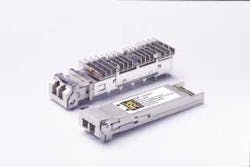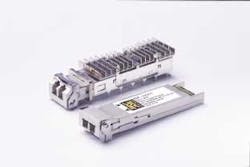10-Gbit/sec XFP modules reach for longer distances
The number of vendors that touted XFPs at the show attests to the popularity of the device, which combines small size, low power, and a serial 10-Gbit/sec interface with line-card electronics. At least 10 companies that spoke with Lightwave either had XFP transceivers on display or on their near-term product roadmaps. As originally envisioned, the module's 850-nm optics limited its application to short-reach links, usually of no more than 600 m. Yet, the recent addition of longer-wavelength, more powerful light sources has produced devices capable of transmitting 10 km and in some cases 40 km.
For example, Intel (Santa Clara, CA) has a 1310-nm device, the TXN18107, which supports 10-km transmission through the use of a distributed-feedback (DFB) laser. Finisar (Sunnyvale, CA) offers a similar module that uses an uncooled DFB; the company expects to have the transceiver available in production quantities by August (see Product Profile, page 33). E2O Communications (Calabasas, CA) offers the DFB-based EM1052. Network Elements (Beaverton, OR) adds 2 km with its 12-km XFP.
In addition, several companies either demonstrated or discussed 40-km devices. Ignis Optics (San Jose, CA) showed a 40-km XFP powered by the 10T101 uncooled 1310-nm externally modulated laser (EML) from ASIP (Somerset, NJ). The company touted the device for both 10-Gigabit Ethernet and SONET/SDH applications. Meanwhile, Finisar demonstrated a 1550-nm device using a cooled EML with an integrated avalanche photodiode (APD). A company spokesman says Finisar believes the integration of a thermo-electric cooler and APD along with the laser and modulator within the XFP form factor constitutes a significant engineering achievement, particularly since the module dissipates <3.5 W. The company also showcased a 40-km version of its 1310-nm device that dissipates <2.5 W.
While the use of laser technology common to 300-pin transponders should be expected in the first XFPs for intermediate reach, the form factor's overall goal of lowest possible cost would imply a desire for cheaper technology. Both Infineon (Munich) and Picolight (Boulder, CO) announced at OFC the development of 1310-nm vertical-cavity surface-emitting lasers (VCSELs) as well as their desire to incorporate their new technology into XFP transceivers. However, VCSEL devices face the obstacle of comparatively low output power.
Newly developed electronic dispersion compensation technology may provide a way around the power problem. While originally discussed for 40-Gbit/sec transponders, chip manufacturers have recently turned their attention to 10-Gbit/sec XFP applications. For instance, AMCC (San Diego) showed the effectiveness of its Niagara S19208 device in conjunction with its S3094 receiver chip in extending the reach of a 1310-nm XFP module supplied by Ignis Optics. The two chips combine forward error correction with electronic dispersion compensation. While the XFP laser used in the demonstration was DFB, the technology also should be applicable to VCSEL devices.
Similarly, Santel Networks also demonstrated a new two-chip approach to electronic dispersion compensation as well as clock and data recovery and multiplexer (CDR-D) functions. The S44501/S44003 OC-192 chipset can help recover up to two-thirds of the optical-signal-to-noise-ratio (OSNR) penalty caused by chromatic dispersion, according to the company. Typical post-compensation residual OSNR penalty is on the order of 2 dB with 100 km of singlemode fiber, compared to 6 dB or higher penalty in a typical uncompensated link. The devices also combat polarization mode dispersion. Currently sampling, the chips should be available in production volumes this quarter.
Of perhaps even more interest to XFP developers, Phyworks (Bristol, UK) unveiled an electronic dispersion compensation chip that measures only 5¥5 mm—small enough to fit within an XFP module. The PHY1060 chip, built in CMOS, offers serial-to-serial power consumption of 0.5 W and serial-to-parallel consumption of 0.75 W. The device, which performs analog processing and contains an integrated limiting amplifier, would reside after the transimpedance amplifier within the module and interface with the line-card transceiver chip. The second revision of the device should reach the sampling stage by August or September.
Electronic dispersion compensation has sparked the interest of XFP developers. For example, Bob Pierce, marketing vice president at E2O Communications, says he saw this technology as a viable approach as
his company works on its 40-km, 1310-nm XFP. In particular, he says electronic dispersion compensation would enable use of XFPs in a wide range of longer-reach applications outside traditional telecom.
However, EMLs and electronic dispersion compensation are not the only choices available to designers. Merge Optics GmbH (Berlin) currently offers a short-reach 1310-nm XFP based on directly modulated, uncooled 1310-nm Fabry-Perot lasers. The company will look to redesign its OptoPack transmitter building block to create an external-cavity-laser architecture based on grating technology. According to Merge Optics chief executive Dag Neumeuer, the resultant device could support transmission distances as great as 80 km. He added that an EML approach would be the company's second choice.
Finally, Essient Photonics (Glasgow) has targeted its electro-absorption modulator technology squarely at XFP applications where longer reach is the goal. The company says its EAM-10 technology also will help achieve XFP Level 2 power of 2.5 W. The EAM-10 device will enter field trials in the first quarter of next year.

